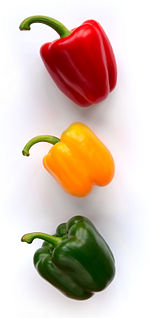Bell pepper
- "Green pepper" redirects here. For green peppercorns, see Black pepper.
| Bell pepper | ||||||||||||||||
|---|---|---|---|---|---|---|---|---|---|---|---|---|---|---|---|---|
 Red, yellow and green pepper
|
||||||||||||||||
| Scientific classification | ||||||||||||||||
|
||||||||||||||||
| Binomial name | ||||||||||||||||
| Capsicum annuum L. |
| Heat: None (SR:0) |
| Pepper, sweet, green raw Nutritional value per 100 g (3.5 oz) |
||||||||||||||||||||||||||||||||||||
|---|---|---|---|---|---|---|---|---|---|---|---|---|---|---|---|---|---|---|---|---|---|---|---|---|---|---|---|---|---|---|---|---|---|---|---|---|
| Energy 20 kcal 80 kJ | ||||||||||||||||||||||||||||||||||||
|
||||||||||||||||||||||||||||||||||||
| Percentages are relative to US recommendations for adults. Source: USDA Nutrient database |
||||||||||||||||||||||||||||||||||||
Bell pepper is a cultivar group of the species Capsicum annuum. Cultivars of the plant produce peppercorns which develop into fruits in different colors, including red, yellow, green and orange. Bell peppers are sometimes grouped with less pungent pepper varieties as "sweet peppers". Peppers are native to Mexico, Central America and northern South America. Pepper seeds were later carried to Spain in 1493 and from there spread to other European and Asian countries. Today, Mexico remains one of the major pepper producers in the world.
Contents |
Nomenclature
The term "bell pepper" is one of the many names for some fruits of the Capsicum annuum species of plants. The misleading name "pepper" (pimiento in Spanish) was given by Christopher Columbus upon bringing the plant back to Europe. At that time peppercorns were a highly prized condiment.
Today the term "bell pepper" or "pepper" or "capsicum" is often used for any of the large bell shaped capsicum fruits, regardless of their color. In British English, the fruit is simply referred to as a "pepper", whereas in many Commonwealth of Nations countries, such as Australia, India, Malaysia and New Zealand, they are called "capsicum". Across Europe, the term "paprika", which has its roots in the word for pepper, is used—sometimes referred to by their color (e. g. "groene paprika", "gele paprika", in Dutch, which are green and yellow, respectively). Paprika also refers to the powdered spice made from the same fruit. In France it is called "poivron", with the same root as "poivre" (meaning "black pepper", or "piment. " In Japan, the word ピーマン ("pîman, " from the French) refers only to green bell peppers, whereas パプリカ ("papurika, " from paprika) refers to bell peppers of other colors. In the United States and Canada, the fruit is often referred to simply as a "pepper" or referred to by color (e. g. "red pepper", "green pepper"), although the more specific term "bell pepper" is understood in most regions. Bell peppers are botanically fruits, but are generally considered in culinary contexts to be vegetables.
In Russia it is commonly called болгарский перец (bolgarskiy perets), meaning Bulgarian pepper. In Denmark the bell pepper is referred to as "peberfrugt", meaning pepper-fruit.
In Brazil it's commonly called Pimentão, meaning Big pepper. It's widely used in a variety of dishes, like pasta, rice and other dishes from Cuisine of Brazil.
In Argentina it's called "Morrón", green and red bell peppers are usually found in small grocery stores, the yellow ones tend to be in the supermarket. Grilled, they may form part of the traditional barbecue of this country, called "Asado" (Castilian Spanish for 'grilled').
Varieties
The color can be green, red, yellow, orange and, more rarely, white, purple, blue, and brown, depending on when they are harvested and the specific cultivar. Green peppers are less sweet and slightly more bitter than red, yellow or orange peppers. The taste of ripe peppers can also vary with growing conditions and post-harvest storage treatment; the sweetest are fruit allowed to ripen fully on the plant in full sunshine, while fruit harvested green and after-ripened in storage are less sweet.
Gallery
See also
- List of capsicum cultivars
- Scoville scale
- Paprika
References
External links
- Bell Pepper page at World's Healthiest Foods
|
|||||||||||||||||